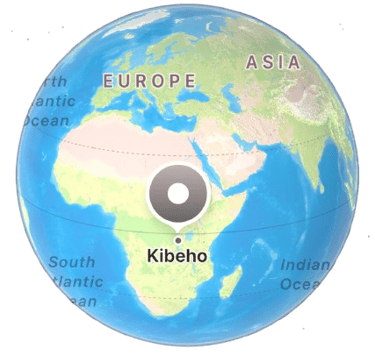What is "Kibeho" and what does it have to do with anything?
Buckle up.
It's a remarkable true story.
KIBEHO
The air was thick with the scent of earth and rain as the hills of Kibeho, Rwanda, Africa, lay bathed in the golden glow of the afternoon sun. It was November 28, 1981 (a familiar date on our wedding website :) — a day like any other, or so it seemed. In the humble courtyard of Kibeho College, a school for girls, Alphonsine Mumureke, a sixteen-year-old student, suddenly froze.
Her body became rigid, her eyes locked onto something beyond the veil of the visible world. The laughter and chatter of her classmates faded as an overwhelming silence filled the space around her. Then, she fell to her knees.
A radiant woman stood before her, dressed in flowing white and blue, her veil shimmering with an unearthly light. Her eyes, deep and sorrowful, bore into Alphonsine’s soul, filling her with a love and peace so powerful that tears streamed down her face.
The woman spoke.
"My daughter, I am the Mother of the Word."
The words, though gentle, carried weight.
At first, Alphonsine’s classmates mocked her, accusing her of seeking attention. But the visions continued. She saw Our Lady wrapped in divine light, radiating love — but she also saw shadows of sorrow behind her beauty.
Then, in 1982, two more girls, Nathalie Mukamazimpaka and Marie-Claire Mukangango, were also chosen to receive Our Lady’s message. Their experiences were even more intense.
One day, Marie-Claire — once a skeptic who had ridiculed Alphonsine — fell into a deep, supernatural trance. She screamed in horror as terrifying visions unfolded before her: rivers of blood, people slaughtering one another, bodies lying lifeless across the land.
As word of the Kibeho apparitions spread, disbelief and skepticism rose just as swiftly. Could three ordinary schoolgirls — Alphonsine Mumureke, Nathalie Mukamazimpaka, and Marie-Claire Mukangango — truly be seeing the Mother of God?
This is where the plot thickens.
The Catholic Church, cautious and methodical, ordered a series of scientific and medical tests to separate truth from illusion, faith from hysteria. The girls were subjected to brutal experiments — trials meant to expose deception, to force a break in the trance-like states they entered during the visions. But what happened defied all human understanding.
Fire could not burn them.
A priest, wanting to test their awareness, took a burning match and pressed it against Nathalie’s arm. She did not flinch. She did not cry out. When the vision ended, she was asked about the burn. Nathalie had no idea what had happened — no pain, no reaction.
Their bodies felt no pain.
Doctors and investigators pinched their skin, pulled their hair, and even pressed needles under their fingernails — things that should have made any person recoil in agony. But the girls felt nothing.
No blood was drawn. No response came.
It was as if they were completely disconnected from the physical world while the visions took place.
Instead, they would remain motionless for long periods, only to rise effortlessly as soon as the apparition ended—completely unharmed.
The Purpose of the Apparitions
The Virgin’s voice, filled with sorrow, echoed in the souls of the three girls:
"If the world does not repent, great suffering will come."
The visions continued for years, each message an urgent plea:
Repent. Pray. Love one another. A terrible war is coming if hearts do not change.
But the warnings were ignored.
Twelve years later, in 1994, Rwanda was consumed by one of the most horrifying genocides in history. The very land where the Virgin had appeared was drenched in blood, just as she had foretold. More than 800,000 people were slaughtered in just 100 days — neighbor against neighbor, friend against friend.
Strength, Forgiveness, Hope
Yet, even in the midst of the horror, her message was not in vain. Many who had listened to Our Lady of Kibeho found the strength to forgive, to reconcile, and to heal. Her presence in Kibeho remains a beacon of hope, reminding the world that even in the face of darkness, conversion, prayer, and love can triumph.
How do you know this is true?
For years, the apparitions of Our Lady of Kibeho remained under investigation. Though the visionaries endured brutal tests and the messages they received were chillingly accurate—foretelling Rwanda’s genocide over a decade before it happened—the Church refused to rush into a conclusion. The process of validation required patience and scientific scrutiny.
As the apparitions occurred between 1981 and 1989, bishops and theologians carefully gathered eyewitness accounts, medical evaluations, and psychological reports on the visionaries. Unlike many alleged apparitions, Kibeho’s case was unique:
The visionaries exhibited supernatural resistance to pain during testing.
Their prophetic warnings of violence and bloodshed later materialized in the Rwandan Genocide of 1994.
The messages emphasized themes deeply rooted in Christian theology: prayer, repentance, and love.
Despite these compelling elements, the Vatican insisted on exhaustive investigations.
On November 28, 2001, exactly 20 years after the first apparition, Kibeho was officially recognized as a Marian pilgrimage site, making it the first and only Vatican-approved apparition in Africa.
If you've ever heard of Lourdes, France — Kibeho is considered the "Lourdes" of Africa.
There are also amazing true stories of apparitions in Fatima, Portugal and Guadalupe, Mexico.
What of it?
Her beautiful message inspires, gives hope, and plants seeds of love.
And when you discover little treasures in life, you want to share them with the people you love.
Love,
J&R
P.S.: Immaculee Ilibagiza, a genocide survivor, hid in a tiny bathroom with 7 other women for 91 days. Her incredible story is on the Tony Robbins Podcast. She's such a light and shares this entire story way better than we ever could!



